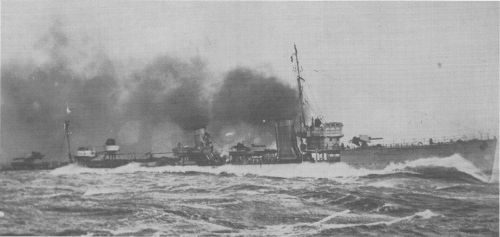- Author
- Francis, Richard
- Subjects
- Ship histories and stories, WWII operations
- Tags
-
- RAN Ships
- HMAS Vampire I
- Publication
- March 2002 edition of the Naval Historical Review (all rights reserved)
HMS Thanet was a destroyer of the “S” Class built in 1918 after the end of WWI and on the outbreak of WW2 was stationed with several sister ships with the Singapore and Hong Kong Local Defence Forces under Flag Officer Malaya. After the sinking of the Prince of Wales and the Repulse, Thanet was one of the few remaining warships in the Naval Base at Singapore. On Christmas Day 1941, she was ordered to sail to search and rescue the crew of a shot down Catalina aircraft, although before she could do so a Dutch submarine had managed to effect the rescue of the airmen.

Destination – Endau
In response to reported Japanese naval forces and a convoy approaching the mouth of the Endau River on the east coast of Malaya on 26 January 1942, HMAS Vampire (Cmdr W T Moran, RAN) with HMS Thanet (Lcdr B S Davies, RN) in company sailed from the Naval Base to investigate and intercept the enemy and if possible, frustrate the troop landings. Both ships sailed at 1630 and when clear of the straits headed for the island of Siribuat, where the enemy force had been reported at anchor. Avoiding detection by various alterations of course and speed both ships reached Siribuat but finding no sign of enemy activity then proceeded to Endau.
Moonset had been at 0200 that night and visibility was poor, perhaps just 2 miles. On approaching Endau in company, Vampire sighted the enemy shipping and fired 3 torpedoes at the Japanese destroyer Shirayuki and the minesweeper WI at close range, without success. It is subsequently thought that the torpedoes had insufficient time to reach their depth setting and may have passed under their targets.
Both ships were promptly illuminated by searchlights as they zig-zagged at full speed under a hail of enemy gunfire. The action became intense as the Japanese warships (Shiriyuki, Fubuki, Asagiri and Yuguri) opened fire on the attackers. Having expended their torpedoes, the Allied destroyers engaged the enemy with their guns.
Action was concentrated on Thanet and she was hit several times in the machinery spaces, soon coming to a stop after a hit in the forward boiler room fracturing her main steam pipe. The Engineer Officer, Lt. George Dickens, RN, lifted the safety valves to release a cloud of steam from the after boilers to avert a subsequent explosion.
Vampire attempted to lay a smoke screen around the hapless Thanet, as they were abandoning ship. Still illuminated by searchlights the Japanese continued firing at the survivors. Vampire was unable to rescue any survivors and made good her escape although she observed some Japanese ships firing at each other at this stage. It was reported later than one enemy destroyer was beached and two troop transports had been heavily damaged. She reached Singapore later the same day. Thanet sank at 0420 while some of the survivors, including the Commanding Officer and his Engineer Officer managed to board boats and Carley floats, and make their way to the shore.
Fate of Thanet Survivors
Later the Japanese destroyer Shirayuki picked up one officer (Sub Lt Danger, RN – the Torpedo Officer) and 30 ratings. Of these, all the ratings were later landed at Endau and turned over to the Japanese Army. (The RN officer was subsequently landed in Indo China and survived the war as a POW). The fate of the ratings is unknown, but they are believed to have been executed the next day by the Japanese (possibly in retaliation for an unexpected reverse suffered at Gemas Bridge in an Australian Army ambush, where hundreds of Japanese were killed, their first defeat suffered during the British retreat through Malaya).
A number of other survivors managed to reach Singapore by various means. In several separate parties, members of Thanet’s crew made their way along the jungle shore, and joined with several shot down aircrew (who had found a boat) and began to row by night and sleep by day, south from the Mersing River, eventually being picked up by a British-manned coaster who brought them to Singapore, together with the Commanding Officer and 11 others in the motor boat. (George Dickens reports being taken to Keppel Harbour and sleeping under the billiard table in the Raffles Hotel).




